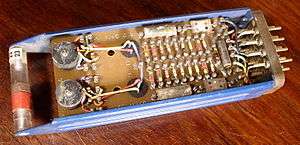TX-2
|
Circuit module from the TX-2. | |
| Developer | MIT Lincoln Laboratory |
|---|---|
| Product family | TX |
| Release date | 1958 |
| Predecessor | TX-0 |
The MIT Lincoln Laboratory TX-2 computer was the successor to the Lincoln TX-0 and was known for its role in advancing both artificial intelligence and human-computer interaction. Wesley A. Clark was the chief architect of the TX-2.[1]
Specifications
The TX-2 was a transistor-based computer using the then-huge amount of 64K 36-bit words of core memory. The TX-2 became operational in 1958. Because of its powerful capabilities Ivan Sutherland's revolutionary Sketchpad program was developed for and ran on the TX-2.[2][3]
Relationship with DEC
Digital Equipment Corporation was a spin-off of the TX-0 and TX-2 projects. A TX-1 was planned as the successor for the TX-0, but the project was deemed too ambitious and was scaled back to the TX-2. The TX-2 Tape System was a block addressable 1/2" tape developed for the TX-2 by Tom Stockebrand which evolved into LINCtape and DECtape.
References
- ↑ Joseph November (2012). "The LINC Revolution". Biomedial Computing, Digitizing Life in the United States. The Johns Hopkins University Press. p. 144.
- ↑ Reilly, Edwin D. (2003) Milestones in Computer Science and Information Technology Greenwood Publishing Group ISBN 9781573565219 pg 261
- ↑ Kalay, Yehuda E. (2004) Architecture's New Media: Principles, Theories, and Methods of Computer-aided Design MIT Press ISBN 9780262112840 pg 66
